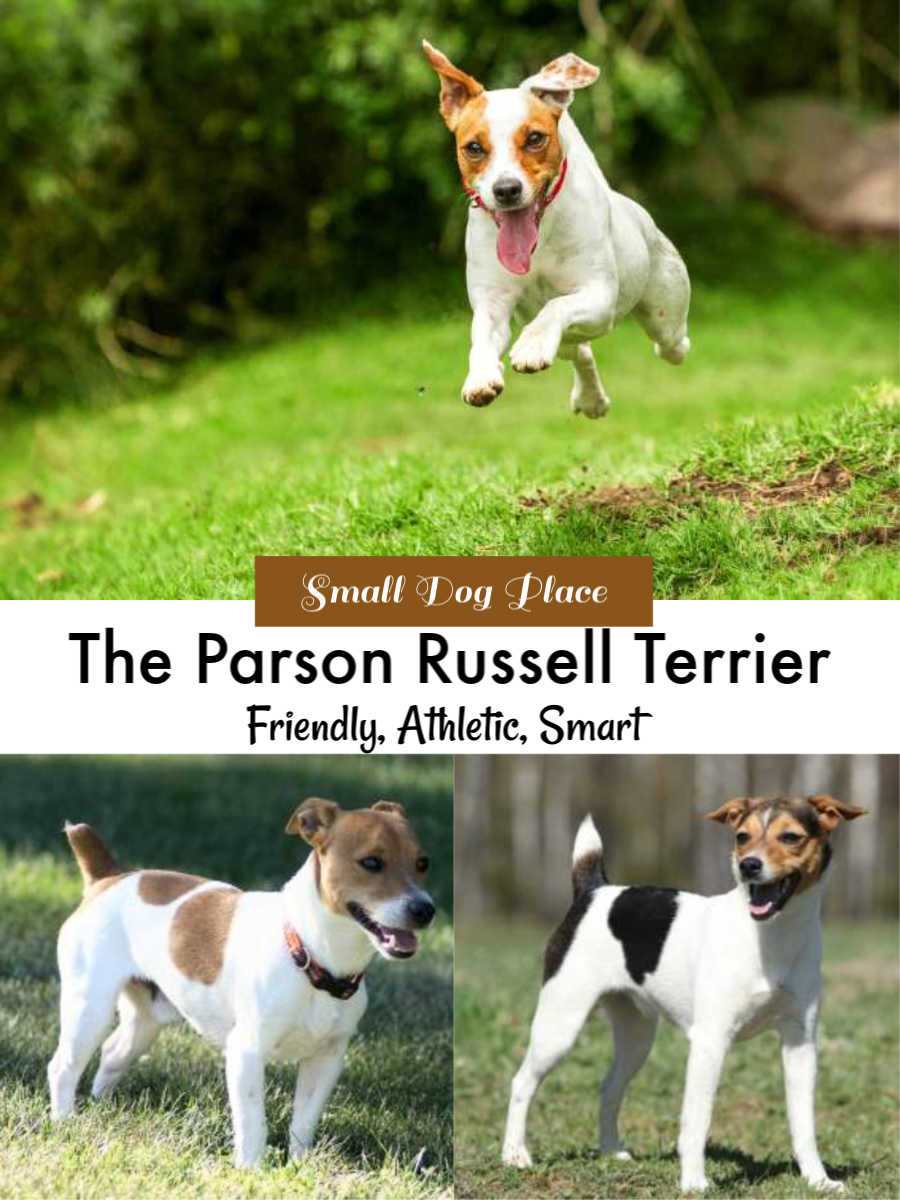- Small Dog Place Home
- A to Z Breed List
- Parson Russell Terrier
Parson Russell Terrier
Your Next Best Friend?
By Janice Jones |Last Updated 10-06-2022
The Parson Russell Terrier is a fantastic breed for very energetic and patient people. Cute as a button, it's hard to resist their friendly, affectionate nature. But, if you are thinking about getting a new four-legged friend, is this the breed for you?
These furry friends are amazing companions and natural performers. They were bred for hunting the red fox in southern England, originally, which is why they have a few distinct characteristics.
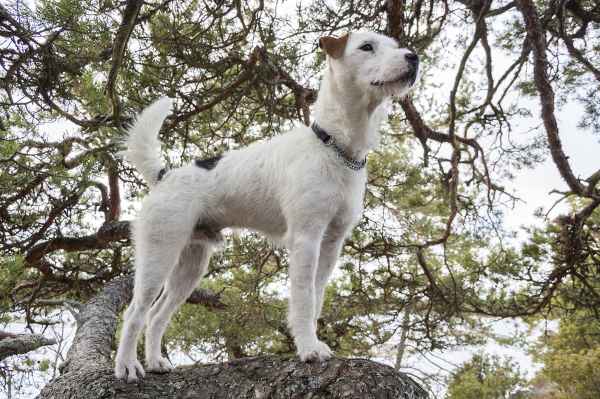 Parson Russell Terriers: Lively, Energetic, Intelligent
Parson Russell Terriers: Lively, Energetic, IntelligentThis includes their small V-shaped ears that fold over onto themselves. The reason they fold over into a ‘V’ shape was to protect the ear from debris in fields and underground when they were hunting and chasing red foxes.
Short legs and small body gave them an advantage when bolting foxes out from their dens.
They also have tight, narrow, and flexible chests that were useful when squeezing and burrowing into tight spaces underground.
What is the difference between a Parson Russell Terrier and a Jack Russell Terrier
There is a lot of confusion and controversy between the Parson Russell Terrier and the Jack Russell Terrier. Maybe I can clear some of that up for you.
There is actually three breeds that are very similar in looks, the Parson, the Jack Russell and the Russell Terrier. The main difference lies in body shape and height. There is also some differences when it comes to kennel registration, but I'll get to that in a moment.
Parson Russell Terrier Height: 12 1/2 to 15 inches
Jack Russell Terrier Height: 10-12 inches
Russell Terrier: 8-12 inches. (Also called the English Jack Russell Terrier or the Short Jack Russell Terrier.)
Shape of Body: The Parson Russell Terrier has more of a squarish body compared to the other two breeds which are considered to be rectangular.
Ease of Grooming: The Jack Russell Terrier has a smooth coat that is easy to manage, although, the Jack Russell Terrier does shed more than the Parson Russell Terrier.
In the U.S., the American Kennel Club (AKC) recognizes the Parson Russell Terrier but not the Jack Russell Terrier.
Australia and other FCI (an international federation of kennel clubs) countries call the Russell terrier a Jack Russell terrier.
With that confusion cleared up and out of the way, let me tell you about the amazing Parson Russell Terrier.
Parsons are extremely lively and a very loyal companion. They are also extremely adaptable and sturdy which makes them ideal for almost any temperature and living situation.
They can be quite noisy and have a couple bad habits that need to be kicked, but despite the usual stereotype with terriers, if you’re looking for a quirky and exciting dog that is bursting with energy, the Parson Russell Terrier will not disappoint.
Quick Facts
Other Names Used: PRT, Parson, Parson Jack Russell
Terrier (AKC recognized 1997-2003)
Affiliation: Terrier group; AKC recognized in 1997
Coat Type: Two types: smooth or broken; The coat is harsh, dense and straight. The Broken coat is slightly longer than the smooth coat. Both types of coats have two layers (Double Coat)
Colors: they can range in color from pure white to white with black or tan markings, to a mixture of all three
Activity Level: High
Good with Children: Parsons do better with children over the age of 6 who knows how to properly handle them, but with proper training and supervision, they can adapt to living with smaller children as well. They do not do well with rough handling from toddlers, and may growl at a child who is mishandling them.
Good with Other Pets: It is extremely important to make sure your Parson is well socialized due to their strong hunting instinct (stronger than other terriers). This being said, they cannot be trusted alone with other small animals, but do okay with larger animals, such as larger dogs etc., and also get along with other Parsons.
Average Litter Size: 5-6
Average Cost: $900 - $1100
The Parson Russell Terrier at a Glance
| Traits | Rating |
|---|---|
| Playfulness | |
| Affection Level | |
| Friendliness Towards Strangers | |
| Good with Children | |
| Good with Other Dogs | |
| Good for First Time Owners | |
| Exercise Needed | |
| Ease of Training | |
| Watch Dog Ability | |
| Grooming Requirements | |
| Shedding | |
| Cold Tolerant | |
| Heat Tolerant |
Explanations for At a Glance Ratings
- Playfulness: Most=5 Less=1
- Affection: Most=5 Least=1
- Friendliness Towards Strangers: Most=5 Least=1
- Good with Children: Good=5 Not Good=1
- Good with Other Dogs: Good=5 Not Good=1
- Good for First Time Owners: Good=5 Not Good=1
- Amount of Exercise Required: Much=5 Minimal=1
- Ease of Training: Easy=5 Difficult=1
- Watch Dog Ability: Excellent=5 Poor=1
- Grooming Needs: Extensive=5 Minimal=1
- Shedding: Heavy Shedding=5 Minimal Shedding=1
- Cold Tolerance: Cold Well Tolerated=5 Poorly Tolerated=1
- Heat Tolerance: Heat Well Tolerated=5 Poorly Tolerated=1
History of the Parson Russell Terrier
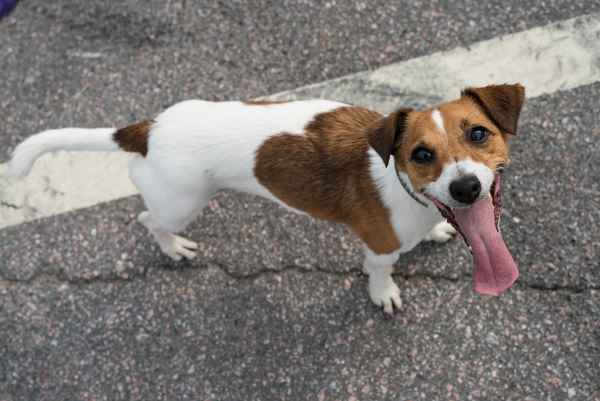 The Parson Russell Terrier or Parson for short.
The Parson Russell Terrier or Parson for short.The Parson Russell Terrier originated in Southern England in the 1800s and got its name from the fox hunting enthusiast and preacher, John Russell (also known as the "Sporting Parson.)
When not attending to his church duties, John Russell enjoyed hunting red foxes. He wanted a terrier that could run alongside the horses and hounds and bolt the foxes out of their den. From there, the hounds took over the chase.
The Jack Russell became a favorite of many sportsmen, especially those who hunted on horseback. John Russell, nicknamed Jack, continued to breed and perfect a dog that was ideally suited to bolt foxes from their den but not kill them.
After John Russell died, the name, "Jack Russell Terrier" was used to describe any terrier that hunted, even those that looked nothing like the terriers that the Rev. Russell developed.
As time went on, the amount of land used for farming increased, so wide open areas where horses could go diminished. The horse method of foxhunting slowly died and only those with large properties could continue to hunt in this way.
It was replaced by hunting on foot and the terriers were used to flush out the foxes or badgers. No horses or hounds needed. The characteristics of the earlier terriers of John Russell were being replaced with ones that were more aggressive and less intelligent. It was these terriers that were imported to the U.S. and called Jack Russell Terriers.
By the 1930s several breed clubs were formed in the U.S. but they all disagreed on the dog's appearance, working ability or potential to compete in conformation shows.
The Jack Russell Terrier Club of America wanted a hunting dog. The Jack Russell Terrier Association of America (JRTAA) wanted the dog to be registered by AKC. The JRTAA worked to restore the breed to its original proportions and function.
The breed was recognized by the AKC in 1997 and then in 2000 it was accepted into AKC's Terrier Group. Finally, in 2003, the breed's name was changed to Parson Russell Terrier to clear up any confusion and differentiate the two breeds. The Jack Russell Terrier Association of America then became the Parson Russell Terrier Association of America.
Personality
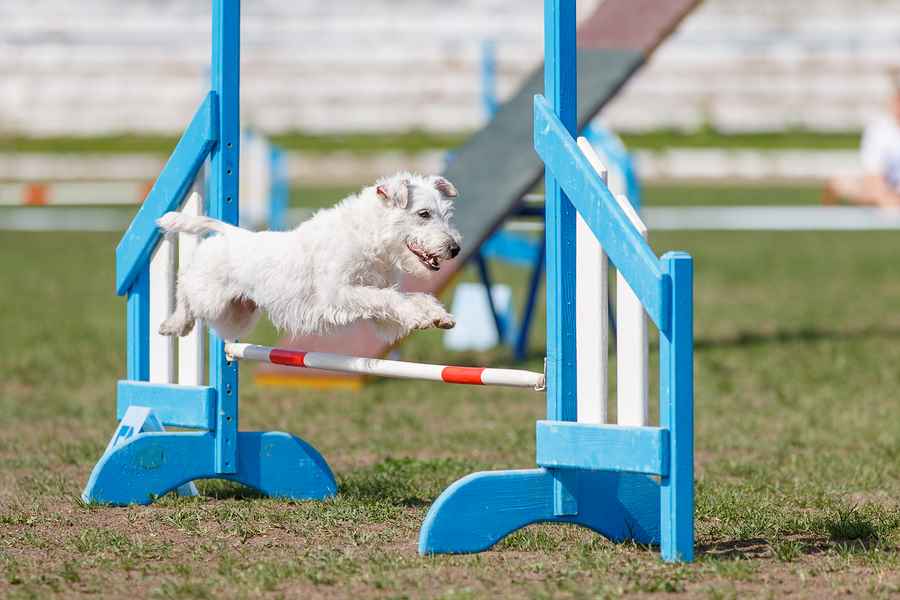 Agility is one sport that the Parson Russell Terrier can excel.
Agility is one sport that the Parson Russell Terrier can excel.The Parson Russell Terrier is a live wire. Bred for speed, they can actually pop 100 balloons in less than a minute. Crazy right?
These dogs are hyper and crazy and they love to run, bark, bounce and climb. This being said, they will climb over fences and run out open doors and gates, so keep this in mind when bringing in the groceries, or leaving a gate open.
Originally bred to dig and hunt, also keep an eye on your Parson when taking them on a walk. If they see another pet or small animal, they have the tendency to want to pursue it.
Also keep a close eye on them while they are outside, especially fenced in backyards, because they might try and dig their way out of the yard.
These quirky dogs are natural performers and will keep you entertained for hours on end, if given the opportunity to. They are extremely cute and spontaneous, which makes them a natural choice and favorite for TV and cinema.
They are bursting with energy, strong willed and very independent, but let’s lay it out on the table; these dogs are NOT for everyone.
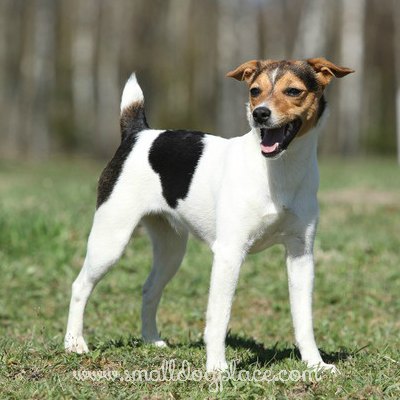 The Parson Russell Terrier
The Parson Russell TerrierThey require a ton of exercise, which could be problems for some people. Parsons are very adaptable and sturdy which means they can live in almost any home and endure pretty much any temperature.
These little guys need a daily outlet to release their wild energy. If they live in an apartment, they need at least an hour run every single day to keep them healthy and happy.
If they live in a house with a big backyard, they can run around for hours out there, especially with other Parsons or dogs.
Like all dogs, they do need supervision during times where they are outside. As silly as it sounds, they can have sensitive skin, and sunscreen needs to be applied to their skin before going outside in the heat.
Parsons are extremely intelligent, but are not that easy to train. Training is essential though because without it, they can wreak havoc on your home, eating the couch, tearing up the walls, etc.
If a Parson is left to its own devices, it will find ways to get itself into trouble. Keep this in mind when leaving your little guy alone for an extended amount of time.
With all this being said, with proper training, they can be the perfect little companions.
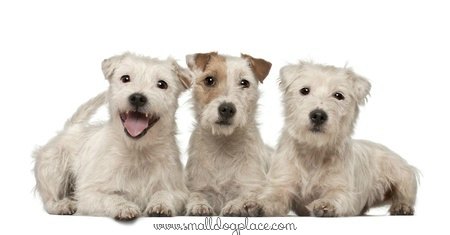 These Parson Russell Terriers have a broken or harsh hair coat.
These Parson Russell Terriers have a broken or harsh hair coat.They are lively and loyal and will be by your side whenever you need them too. If you’re an experienced trainer then the Parson is the perfect dog for you, but if you are not then you may have to be careful because they are known to outsmart the average pet owner.
Parsons are not highly recommended for first time or inexperienced dog owners. They are very smart and always thinking.
They seem to be one step ahead and they want to do what they want to do and they might try and train you. Do not let your Parson fall into Small Dog Syndrome.
This means that they will try and control you because they think that they are the pack leader. You need to be strong and confident in training your Parson so this does not happen. Without proper training they can become anxious and distraught.
Grooming
The Parson Russell Terrier has 2 distinct coat textures, which include smooth and rough or broken. They have very minimal shedding and the smooth coat sheds more than the rough coat. Their weatherproof double coat protects them from the elements and underbrush. They have minimal grooming needs and are easy to maintain.
A quick brush with a firm bristle or pin brush will do the trick. They need to be given a bath when needed along with the other necessary hygienic routines such as nail clipping, checking their ears, brushing their teeth, etc.
If they are going to be shown, they need to have their coat stripped and the broken coat needs to be hand stripped, but other than that they are very easy to groom and maintain.
Health Concerns
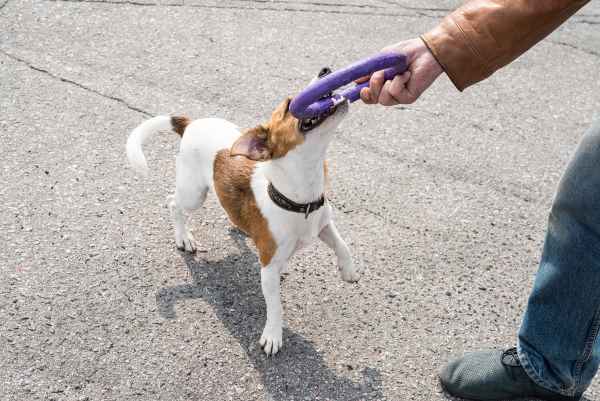 Parson Russell Terrier needs plenty of exercises and playtime to stay healthy.
Parson Russell Terrier needs plenty of exercises and playtime to stay healthy.This is a fairly healthy dog and they live for a very long time because of it. They only have a few health concerns that can be prominent in any small dog breed.
- Cataracts
- Progressive
Retinal Atrophy
- Patellar
Luxation
- Posterior
Vitreous Detachment
- Legg-Perthes disease
- Deafness
- Eye issues, including glaucoma and lens luxation
- Ataxia, a loss of coordination due to sensory dysfunction
You can avoid many of these problems by finding a reputable breeder that screens and tests the parent dogs before breeding.
They can test eyes by contacting a board certified ophthalmologist. A BAER test done on the parents will assure that they have normal hearing in both ears. Knees can be checked by a veterinarian and there are several DNA tests that can detect problems associated with Ataxia and lens luxation.
Feeding
Parson Russell Terriers do well on a high quality commercial food that is made up of predominately meat based proteins and is approved for a specific life stage such as puppy, adult, or senior. The AAFCO statement on the dog food label should state which growth stage the food is intended or it should say that it is formulated for all life stages.
For a typical 15 pound Parson Russell Terrier, the daily caloric requirement is 473 kcal per day which should be divided into two meals. Puppies under six months old should receive 3 daily meals.
Look at the ingredient list to see what type of food is listed there. They are listed in descending order by weight beginning with the heaviest ingredient first. Count and examine the ingredients that are listed before the first fat source such as chicken fat. Those are the ingredients that are the most abundant and important. Anything after the fat source is not likely to contribute as much to the overall formula.
Look for individually named meats, fish or eggs, sources of carbohydrates and types of fibers. Avoid animal byproducts or fat sources that aren't name but listed as poultry fat.
Lifestyle
Best Owners for Parson Russell Terriers
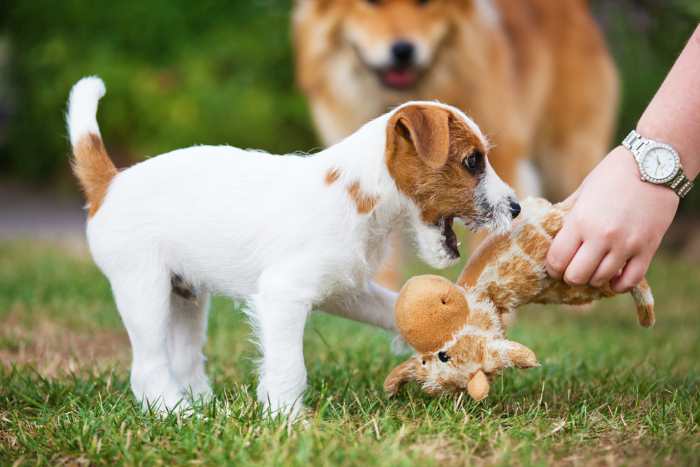
If your favorite hobby is sitting in front of the television for hours, this is not the breed for you. They need exercise and activity and do best with active families, couples, and singles ready and eager to meet their needs.
The best owner will have had some experience living with and training dogs. Novice owners are likely to get frustrated by the fast paced lifestyle demanded of them by their Parson.
Parson Russell Terriers can be a great choice for a family with children who not only enjoy playing with but also participating in their dog's training and socialization. Though these dogs love children, very young babies and toddlers may not make the best playmates for these rambunctious canines.
The breed can do well in an apartment setting, but a long walk or two per day is necessary to use up some of their excess energy. They love to run and play, so if you do live in an apartment, be sure to scour the neighborhood for a good dog park, especially one that has separate areas for small dogs.
In a home setting, a securely fenced yard is a must. They will jump and dig so supervision is also required. An electric fence is unlikely to keep this terrier safely confined to his property.
Energy Level and Activity Needs
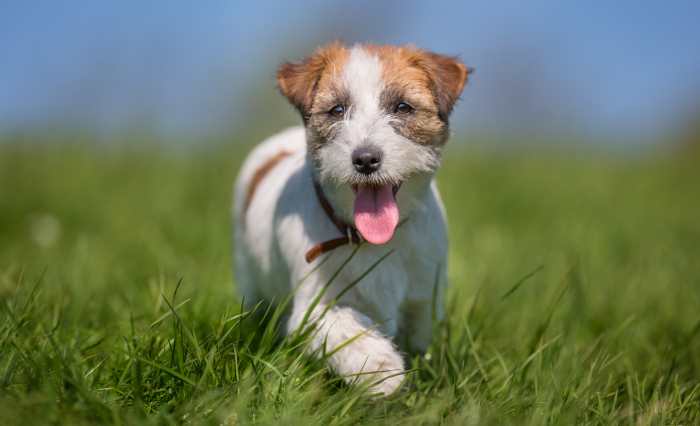
As mentioned above, this is a high energy dog and dogs who do not get their energy demands met on a daily basis are likely to get into trouble and can be destructive. If you work outside the home, arrange to come home for lunch or hire someone to walk the dog while you're at work.
These dogs love to play and a fast paced game of fetch can help tire them out. When weather doesn't permit it, rigorous indoor play will help calm your energetic dog.
Training the Parson Russell Terrier
The Parson Russell Terrier is a highly intelligent breed that is used repeatedly in TV, movies, and can be seen across the web in cute photographs showing off tricks and entertaining anyone who will watch. But all that cuteness and control didn't occur overnight. It takes socialization and countless hours of training.
Socialization and early training are essential for any puppy, but especially the Parson Russell Terrier. Puppies can be rambunctious and it's easy to loose control or not gain control. Start on day one with house training, and learning some manners.
Always use a positive training and keep training sessions short and consistent. The Parson Russell Terrier is very intelligent and will catch on quickly. The trick is to keep that training momentum going as they get older. It will pay off in the end and you'll have an adult who is well mannered, happy and trained.
Pros and Cons of the Breed
Pros:
- Doesn’t shed a lot;
- Easy grooming needs
- Loyal
- Athletic and energetic
- Very adaptable
- Long lifespan
Cons:
- Can bark a lot
- Can be difficult to train
- Feisty and assertive
- Not good for inexperienced owners
- Needs much daily exercise
- May dig
Please Pin for Future Reference
Books & Additional Resources
Breed Club: Parson Russell Terrier Association of America
About Janice (author and voice behind this site)
Janice Jones has lived with dogs and cats for most of her life and worked as a veterinary technician for over a decade. She has also been a small-breed dog breeder and rescue advocate and holds academic training in psychology, biology, nursing, and mental health counseling. Her work focuses on helping dog owners make informed, responsible decisions rooted in experience, education, and compassion.
When not writing, reading, or researching dog-related topics, she likes to spend time with her six Shih Tzu dogs, her husband, and her family, as well as knitting and crocheting. She is also the voice behind Miracle Shih Tzu and Smart-Knit-Crocheting
Does This Article Deserve Your Thumbs Up?
We always appreciate your support and encouragement. Your thumbs up means so much to us. Please like this article.
If you find this page or any page on Small Dog Place Helpful, or useful in anyway, I'd love it if you would click the small heart found on the bottom right of each page.
You can also share or bookmark this page -- just click on the:

Free Monthly Newsletter
Sign Up for Our Free Newsletter and get our Free Gift to You.
my E-book, The Top 10 Mistakes People Make When Choosing a Dog (and how to avoid them)
